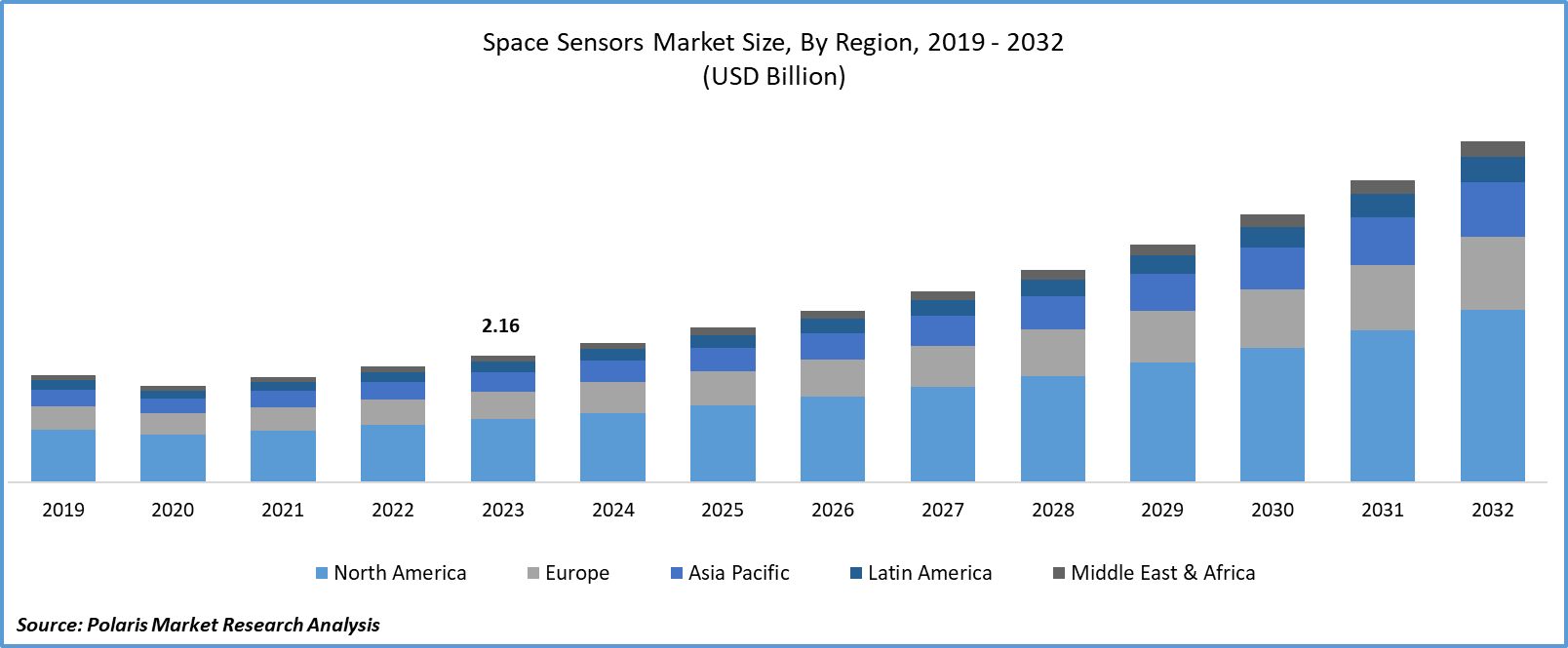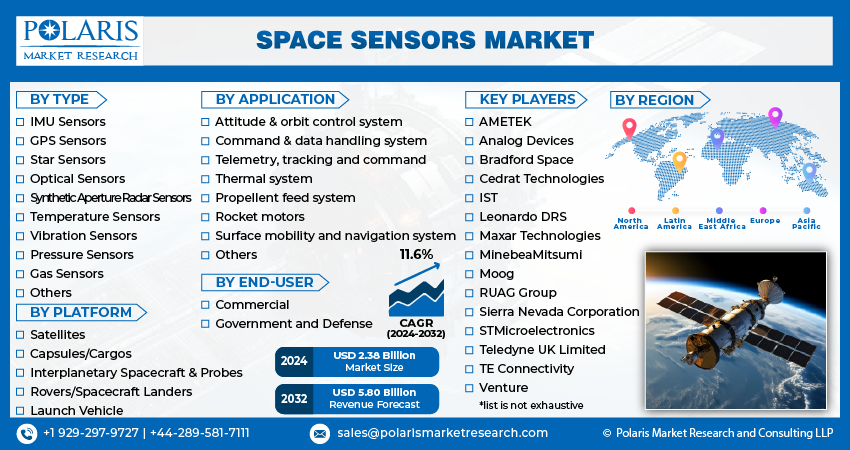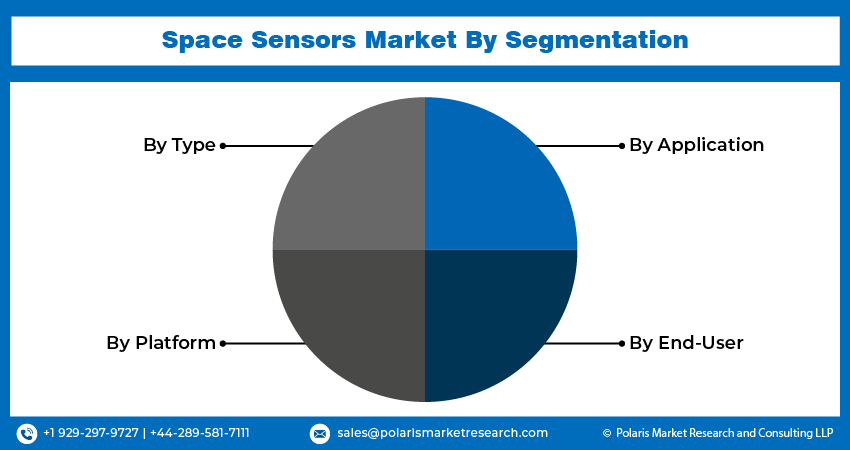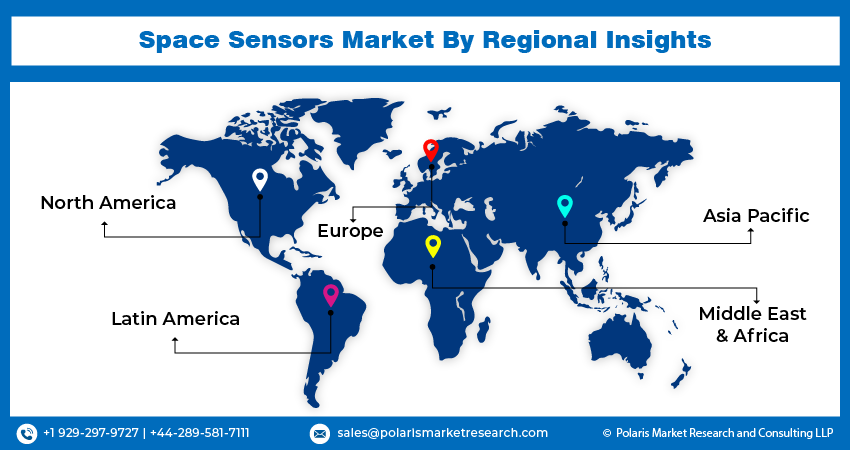
Space Sensors Market Share, Size, Trends, Industry Analysis Report, By Type (IMU Sensors, GPS Sensors, Star Sensors, Optical Sensors, and Others); By Platform; By Application; By End User; By Region; Segment Forecast, 2024- 2032
- Published Date:Feb-2024
- Pages: 117
- Format: PDF
- Report ID: PM4314
- Base Year: 2023
- Historical Data: 2019 – 2022
Report Outlook
The global space sensors market was valued at USD 2.16 billion in 2023 and is expected to grow at a CAGR of 11.6% during the forecast period.
The evolution of space sensors for various purposes is one of the primary factors driving the growth of the space sensor market globally. In 2022, MIT scientists developed initial digitally made plasma sensors, which are also known as retarding potential analyzers, for orbiting spacecraft used by satellites to identify chemical compositions and ion energy distribution in the atmosphere. The ongoing research studies on finding planets' atmospheres to identify the suitability of life among space research organizations are likely to stimulate the demand for space sensors in the coming years.
- For instance, in June 2023, the National Aeronautics and Space Administration (NASA) accorded USD 4 million to the research team led by astronomer Michael Bottom of the University of Hawaiʻi Institute for Astronomy (IfA) for assistance in their exo-planet research. This grant is used to build ultra-sensitive sensors to observe distant planets & their atmosphere.

To Understand More About this Research: Request a Free Sample Report
Moreover, the application of space sensors in monitoring weather conditions, tourism safety, environmental monitoring, and disaster management is expected to drive technological advancements in the market. However, the launch failures and budget constraints among the private and government space organizations are factors which hampers the growth of the market.
Industry Dynamics
Growth Drivers
Rising technological innovations in space sensors propels the growth of the market
The rising technological innovations, research, and development activities in the field of space sensors are expected to propel the growth and expansion of the market throughout the study period. Vector Atomic, a California-based startup, in collaboration with Honeywell Aerospace, delivered a quantum navigation sensor funded by the defense innovation. This sensor utilizes an atomic clock rather than depending on GPS to have accurate measurements. This sensor is waiting for the launch into space orbit. These factors are contributing to the demand for the space sensors market in the coming years.

Report Segmentation
The market is primarily segmented based on type, platform, application, end-user, and region.
|
By Type |
By Platform |
By Application |
By End-User |
By Region |
|
|
|
|
|
To Understand the Scope of this Report: Speak to Analyst
By Type Analysis
Optical sensors segment is expected to witness the highest growth during the forecast period
The optical sensors segment will grow rapidly, mainly driven by its use in exploring the universe and earth. It provides high-quality images with the accurate size, shape, and orientation of objects in space, contributing to the increased adoption of automotive, robotics, medical devices, consumer electronics, industrial automation, and more.
The Inertial Measurement Unit Sensors segment led the industry market with a substantial revenue share in 2022, largely attributable to its use in measuring orientation, angular rates, and acceleration. The rising global earth exploration activities are fueling the demand for these sensors, as they can track the earth's magnetic field and air pressure.
By Platform Analysis
Satellites segment accounted for the largest market share in 2022
The satellites segment accounted for the largest market share. The increasing number of satellites among nations from governments and private companies is likely to stimulate the space sensor market. According to India's Upper House of Parliament, 199 satellites have been launched in the past 19 years. The increased use of satellites is gaining traction nowadays, attributable to their growing applications in the global market, including railways, water mapping, telemedicine, and robotic surgery.
The launch vehicle segment is expected to grow at the fastest rate over the next few years on account of the rapid increase in spacecraft launch activities for various purposes, including the planet's atmosphere and research studies. Recently, the Indian Space Research Organisation (ISRO) launched 104 PSLV-C37 satellites from Satish Dhawan Space Centre, Sriharikota, of which 101 are associated with international customers. This demonstrates the increasing need for spacecraft launch vehicles, driving the demand for sensors, which play a vital role in navigation, monitoring, and orientation.
By Application Analysis
Altitude and Orbit control system segment held the significant market revenue share in 2022
The altitude and orbit control system segment held a significant market share in revenue in 2022, which is highly accelerated due to enhanced satellite communication. They provide stabilized earth-pointing altitude control in all mission modes and measure spacecraft rates and orbital positions. The satellites, with their accurate altitude and orbit control system, can transfer information to the ground station with a higher signal strength.
By End User Analysis
Government and Defense segment held the significant growth share in 2022
The government and defense segment held a significant growth share in 2022, which is highly accelerated due to the continuous rise in government investments in national security attributable to the growing disputes among the countries. Sensors can monitor borders and identify potential threats, boosting their demand among nations.

Regional Insights
North America region registered the largest share of the global market in 2022
The North America region dominated the global market. The presence of nations with advanced space technologies, like the U.S. space agency NASA, is contributing to the growth of this region. It is positioned to focus on the development of space-based sensors that are more sophisticated electro-optical satellite payloads to keep an eye on the evolution of the planet's environment. As the agencies in the region work on advancements in space sensor technologies, it is likely to continue its market position in the coming years.
The Asia Pacific region is expected to be the fastest-growing region with a healthy CAGR during the projected period, owing to the growing space development activities in the region. The countries in the region, including China, Japan, and India, are increasing space exploration activities, driving innovations in space sensors. According to the article published in the Economic Times in 2023, GalaxEye, a Chennai-based startup, announced its plan to unveil the world's first multi-sensor satellite next year. This satellite will capture synthetic aperture radar (SAR) data and data from optical sensors to enhance the analytical utility generated from the data.

Key Market Players & Competitive Insights
The space sensors market is consolidated, driven by increasing mergers and acquisitions, collaborations, and partnerships among the key market players to expand their market share and global market presence and withstand competition from competitors. The technological advancements and strategic planning among the market players are widening the market scope. For instance, in 2023, ATL partners such as GEOST LLC and Ophir Corporation formed Lightridge Solutions for space, airborne, and payload development.
Some of the major players operating in the global market include:
- AMETEK
- Analog Devices
- Bradford Space
- Cedrat Technologies
- Cobham Advanced Electronic Solutions
- Honeywell International
- IST
- Leonardo DRS
- Maxar Technologies
- MinebeaMitsumi
- Moog
- Raytheon Technologies Corporation
- Renesas Electronics Corporation
- RUAG Group
- Sierra Nevada Corporation
- STMicroelectronics
- Teledyne UK Limited
- Texas Instruments Incorporated
- TE Connectivity
- Venture
Recent Developments
- In March 2023, NASA awarded USD 15 million to the new Quantum Pathways Institute, led by the University of Texas at Austin, for the next five years to support the development of quantum sensors in space. This team includes researchers from UT Austin, the University of Colorado Boulder, the University of California, Santa Barbara, the California Institute of Technology, and the U.S. National Institute for Standards and Technology.
Space Sensors Market Report Scope
|
Report Attributes |
Details |
|
Market Size Value in 2024 |
USD 2.38 billion |
|
Revenue Forecast in 2032 |
USD 5.80 billion |
|
CAGR |
11.6% from 2024 – 2032 |
|
Base year |
2023 |
|
Historical Data |
2019 – 2022 |
|
Forecast Period |
2024 – 2032 |
|
Quantitative Units |
Revenue in USD billion and CAGR from 2024 to 2032 |
|
Segments Covered |
By Type, By Platform, By Application, By End-User, By Region |
|
Regional Scope |
North America, Europe, Asia Pacific, Latin America, Middle East & Africa |
|
Customization |
Report customization as per your requirements with respect to countries, region and segmentation. |
FAQ's
The global space sensors market size is expected to reach USD 5.80 billion by 2032, according to a new study by Polaris Market Research.
Key players in the market are AMETEK, Analog Devices, Bradford Space, Cedrat Technologies
North America contribute notably towards the global Space Sensors Market
The global space sensors market is expected to grow at a CAGR of 11.6% during the forecast period.
The Space Sensors Market report covering key segments are type, platform, application, end-user, and region.
